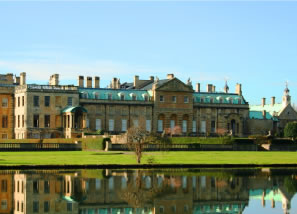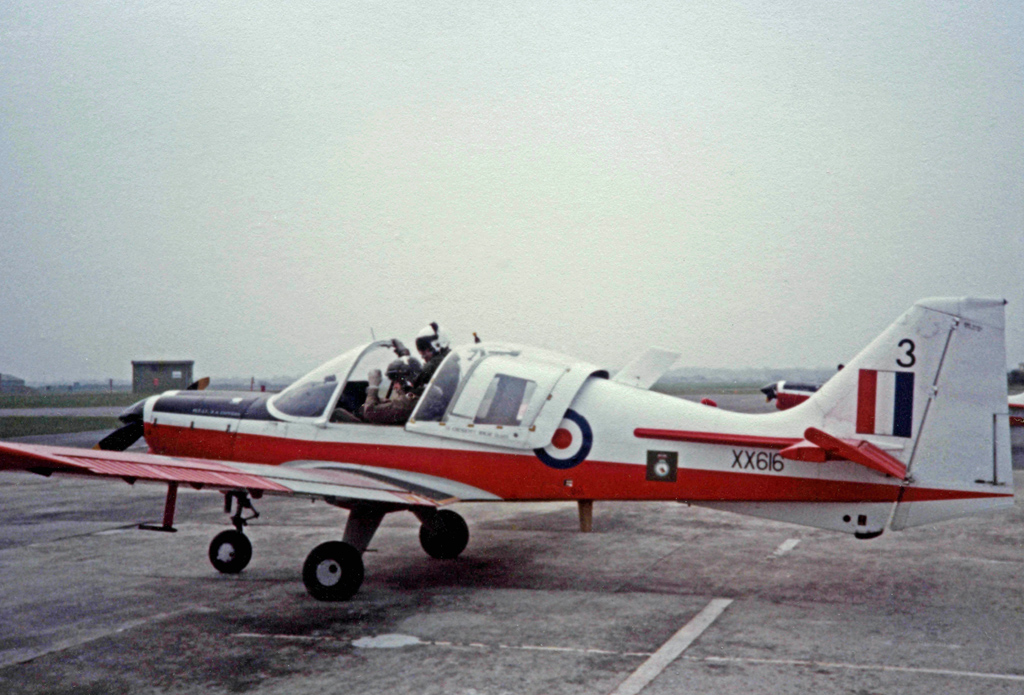|
RAF Volunteer Reserve
The Royal Air Force Volunteer Reserve (RAFVR) was established in 1936 to support the preparedness of the U.K. Royal Air Force in the event of another war. The Air Ministry intended it to form a supplement to the Royal Auxiliary Air Force (RAuxAF), the active reserve for the RAF, by providing an additional non-active reserve. However during the Second World War the high demand for aircrew absorbed all available RAuxAF personnel and led the RAFVR to quickly become the main pathway of aircrew entry into the RAF. It was initially composed of civilians recruited from neighbourhood reserve flying schools, run by civilian contractors with largely RAF-trained flying instructors as well as other instructors in related air war functions, such as observers and wireless operators. After the war, and with the end of conscription in the early 1960s, the RAFVR considerably reduced in size and most functions were absorbed into the RAuxAF. The RAFVR now forms the working elements of the University ... [...More Info...] [...Related Items...] OR: [Wikipedia] [Google] [Baidu] |
United Kingdom
The United Kingdom of Great Britain and Northern Ireland, commonly known as the United Kingdom (UK) or Britain, is a country in Europe, off the north-western coast of the European mainland, continental mainland. It comprises England, Scotland, Wales and Northern Ireland. The United Kingdom includes the island of Great Britain, the north-eastern part of the island of Ireland, and many List of islands of the United Kingdom, smaller islands within the British Isles. Northern Ireland shares Republic of Ireland–United Kingdom border, a land border with the Republic of Ireland; otherwise, the United Kingdom is surrounded by the Atlantic Ocean, the North Sea, the English Channel, the Celtic Sea and the Irish Sea. The total area of the United Kingdom is , with an estimated 2020 population of more than 67 million people. The United Kingdom has evolved from a series of annexations, unions and separations of constituent countries over several hundred years. The Treaty of Union between ... [...More Info...] [...Related Items...] OR: [Wikipedia] [Google] [Baidu] |
National Service (Armed Forces) Act 1939
The National Service (Armed Forces) Act 1939 was enacted by the Parliament of the United Kingdom on 3 September 1939, the day the United Kingdom declared war on Germany at the start of the Second World War. It superseded the Military Training Act 1939 (enacted in May of that year) and enforced full conscription on all male British subjects between 18 and 41 who were present in Great Britain, subject to certain exemptions. By a royal declaration in January 1941, the term Great Britain was extended to include the Isle of Man.''The London Gazette'', 31 January 1941p. 622/ref> Despite the end of the war in September 1945, the Labour government kept the Act in force until 1948, when its impacts were continued in a modified form by the enactment of the National Service Act 1948. Exemptions *Medically unfit as well as the blind, disabled, and those with mental disorders *British subjects from outside Britain and the Isle of Man who had lived in the country for less than two years *Stud ... [...More Info...] [...Related Items...] OR: [Wikipedia] [Google] [Baidu] |
Volunteer Gliding Squadrons
Volunteer Gliding Squadrons (VGSs) are Royal Air Force (UK) Flying Training units, operating military Viking T1 conventional gliders to train cadets from the Royal Air Force Air Cadets. Since 2014, the squadrons operate under No. 2 Flying Training School, which was newly reformed for this purpose at RAF Syerston, Nottinghamshire, within No.22 (Training) Group of the Royal Air Force. The 10 Units, along with the Royal Air Force Central Gliding School, are standardised annually by the Royal Air Force Central Flying School. Formerly under the Air Cadet Organisation prior to 2010, Headquarters Air Cadets presently still retains administrative support. VGSs are made up of volunteer staff. Each is headed by a Commanding Officer and several executives, who are appointed by a Cadet Forces Commission in the RAF Air Cadets. Instructors are a mixture of regular RAF/RN/Army personnel, reservists, RAFAC personnel, Civilian Gliding Instructors (CGIs) and Flight Staff Cadets (FSCs). Hist ... [...More Info...] [...Related Items...] OR: [Wikipedia] [Google] [Baidu] |
Combined Cadet Force
The Combined Cadet Force (CCF) is a youth organisation in the United Kingdom, sponsored by the Ministry of Defence (MOD), which operates in schools, and normally includes Army, Royal Navy and Royal Air Force sections. Its aim is to "provide a disciplined organisation in a school so that pupils may develop powers of leadership by means of training to promote the qualities of responsibility, self reliance, resourcefulness, endurance and perseverance". One of its objectives is "to encourage those who have an interest in the services to become Officers of the Regular or Reserve Forces", and a significant number of British military officers have had experience in the CCF. Before 1948, cadet forces in schools existed as the junior division of the Officers' Training Corps framework, but in 1948 Combined Cadet Force was formed covering cadets affiliated to all three services. As of 2019, there were 42,720 cadets and 3,370 Adult Volunteers. The MOD provides approximately £28M per yea ... [...More Info...] [...Related Items...] OR: [Wikipedia] [Google] [Baidu] |
Air Training Corps
The Air Training Corps (ATC) is a British volunteer-military youth organisation. They are sponsored by the Ministry of Defence and the Royal Air Force. The majority of staff are volunteers, and some are paid for full-time work – including Commandant Air Cadets, a Full Term Reserve Service RAF officer. In 2013, the officer in command of the ATC was Air Commodore Dawn McCafferty. Although many ATC cadets go on to join the RAF or other services, the ATC is not a recruiting organisation for its parent service. Activities include sport, adventure training (such as walking and paddle-sports), ceremonial drill, rifle shooting, field craft, powered aircraft, glider flying, and other outdoor activities, as well as classification training leading up to a BTEC in Aviation Studies. Week-long trips to RAF stations, or camps offering adventure training or music, allow the opportunity for cadets to gain a taste of military life and often some flying experience in RAF gliders and RAF tra ... [...More Info...] [...Related Items...] OR: [Wikipedia] [Google] [Baidu] |
Welbeck Defence Sixth Form College
Welbeck Defence Sixth Form College (stylised as Welbeck – The Defence Sixth Form College), formerly named and often referred to as simply Welbeck College, was an independent, selective sixth form college in Leicestershire, England. While run as a sixth form college, the school was an institution of the Ministry of Defence and part of the Defence Academy of the United Kingdom. Founded in 1953, the school was originally based at Welbeck Abbey, where it provided A-level education for boys planning to join the technical branches of the British Army. By 2004, the school accepted both male and female students for all three branches of the armed forces and in 2005, the school was re-opened and relocated to a purpose-built site in Leicestershire, where it also began admitting potential civil servants for the Defence Engineering and Science Group within the Ministry of Defence. The school closed on 3 July 2021. History Foundation Recognising a decline in the number of cadets passi ... [...More Info...] [...Related Items...] OR: [Wikipedia] [Google] [Baidu] |
University Air Squadrons
University Air Squadrons are training units under the command of No. 6 Flying Training School RAF of the Royal Air Force and their main role is to attract students into careers as RAF officers. Primarily its goal is achieved through offering basic flying training, force development and adventure training to undergraduate students at British universities. These units exist to provide a taste of life in the Service and to give experience to their members in preparation for taking up a career as an officer in one of the RAF's many branches. Members are expected to attend training nights, usually on a weekly basis, as well as attending several annual training camps. The flying syllabus of 31 sorties loosely follows Elementary Flying Training (EFT) and allows a student to achieve some ten to fifteen hours of flying per year. The flying training is supplemented with ground training and adventure training, both in the UK and abroad. UASs are part of the RAF Volunteer Reserve (RAFVR ... [...More Info...] [...Related Items...] OR: [Wikipedia] [Google] [Baidu] |
Air Experience Flight
An Air Experience Flight (AEF) is a training unit of the Royal Air Force Volunteer Reserve (Training Branch) whose main purpose is to give introductory flying experience to cadets from the Air Training Corps and the Combined Cadet Force. As of 2019, thirteen AEFs are active. History The AEFs, numbered from 1 to 13, were formed across the United Kingdom in 1958, all but two forming on the same day, 8 September. All were equipped with the de Havilland Canada DHC-1 Chipmunk T.10 trainer. An exception was No. 5 AEF, which also operated a single Beagle Husky (''XW635'') from 1969 to 1989. In the mid-1990s they were merged with co-located University Air Squadrons (UASs), the Chipmunks being replaced by the existing UAS Scottish Aviation Bulldog T.1s. No. 13 AEF at RAF Aldergrove was disbanded in 1996. In 1999, the Grob Tutor T.1 began to replace the Bulldog. On 10 March 2016, Julian Brazier, Parliamentary Under-Secretary (Ministry of Defence), announced the return of 13 AEF and a ... [...More Info...] [...Related Items...] OR: [Wikipedia] [Google] [Baidu] |
Royal Air Force Volunteer Reserve (Training Branch)
The Royal Air Force Volunteer Reserve (Training Branch), often abbreviated to RAFVR(T), was a Volunteer Reserve element of the Royal Air Force specifically appointed in a cadet training role within the Royal Air Force Volunteer Reserve. Members of the RAFVR(T) had no call-up liability and often operated part-time with the Air Experience Flights and Volunteer Gliding Squadrons, which provide flight experience for the Royal Air Force Air Cadets. In December 2017, the Air Force Board determined that RAFVR(T) ranks as part of the Royal Air Force Air Cadets would be removed. This was to make way for the introduction within all MOD-sponsored cadet forces of the Cadet Forces Commission (CFC), which was introduced in 2017 and restated in 2018. Recruitment and selection Initial selection The majority of the pilots who staff the Air Experience Flights (AEF) are former regular service aircrew (RAF, Army or RN), some of them at Air rank serving as supernumerary Flying Officers RAFVR(T); ad ... [...More Info...] [...Related Items...] OR: [Wikipedia] [Google] [Baidu] |
Commanding Officer
The commanding officer (CO) or sometimes, if the incumbent is a general officer, commanding general (CG), is the officer in command of a military unit. The commanding officer has ultimate authority over the unit, and is usually given wide latitude to run the unit as they see fit, within the bounds of military law. In this respect, commanding officers have significant responsibilities (for example, the use of force, finances, equipment, the Geneva Conventions), duties (to higher authority, mission effectiveness, duty of care to personnel), and powers (for example, discipline and punishment of personnel within certain limits of military law). In some countries, commanding officers may be of any commissioned rank. Usually, there are more officers than command positions available, and time spent in command is generally a key aspect of promotion, so the role of commanding officer is highly valued. The commanding officer is often assisted by an executive officer (XO) or second-in-c ... [...More Info...] [...Related Items...] OR: [Wikipedia] [Google] [Baidu] |
Bounty (reward)
A bounty is a payment or reward of money to locate, capture or kill an outlaw or a wanted person. Two modern examples of bounties are the ones placed for the capture of Saddam Hussein and his sons by the United States government and Microsoft's bounty for computer virus creators. Those who make a living by pursuing bounties are known as bounty hunters. Examples Historical examples Written promises of reward for the capture of or information regarding criminals go back to at least the first-century Roman Empire. Graffiti from Pompeii, a Roman city destroyed by a volcanic eruption in 79 AD, contained this message: A copper pot went missing from my shop. Anyone who returns it to me will be given 65 bronze coins ( ''sestertii''). Twenty more will be given for information leading to the capture of the thief. A bounty system was used in the American Civil War as an incentive to increase enlistments. Another bounty system was used in New South Wales to increase the number of immigr ... [...More Info...] [...Related Items...] OR: [Wikipedia] [Google] [Baidu] |
Air Ministry
The Air Ministry was a department of the Government of the United Kingdom with the responsibility of managing the affairs of the Royal Air Force, that existed from 1918 to 1964. It was under the political authority of the Secretary of State for Air. Organisations before the Air Ministry The Air Committee On 13 April 1912, less than two weeks after the creation of the Royal Flying Corps (which initially consisted of both a naval and a military wing), an Air Committee was established to act as an intermediary between the Admiralty and the War Office in matters relating to aviation. The new Air Committee was composed of representatives of the two war ministries, and although it could make recommendations, it lacked executive authority. The recommendations of the Air Committee had to be ratified by the Admiralty Board and the Imperial General Staff and, in consequence, the Committee was not particularly effective. The increasing separation of army and naval aviation from 1 ... [...More Info...] [...Related Items...] OR: [Wikipedia] [Google] [Baidu] |





